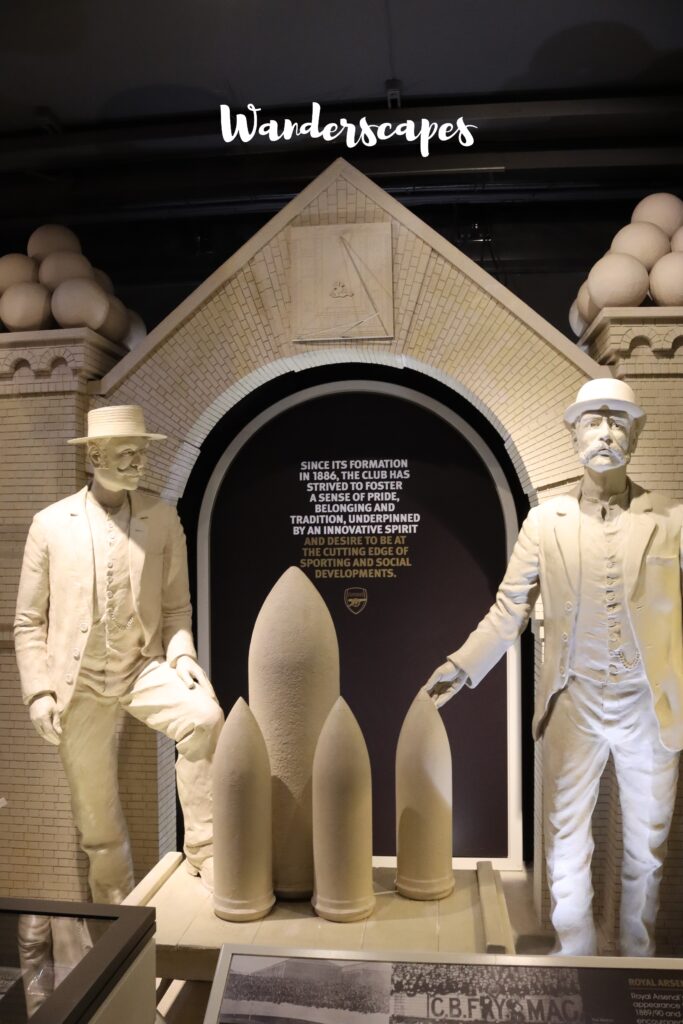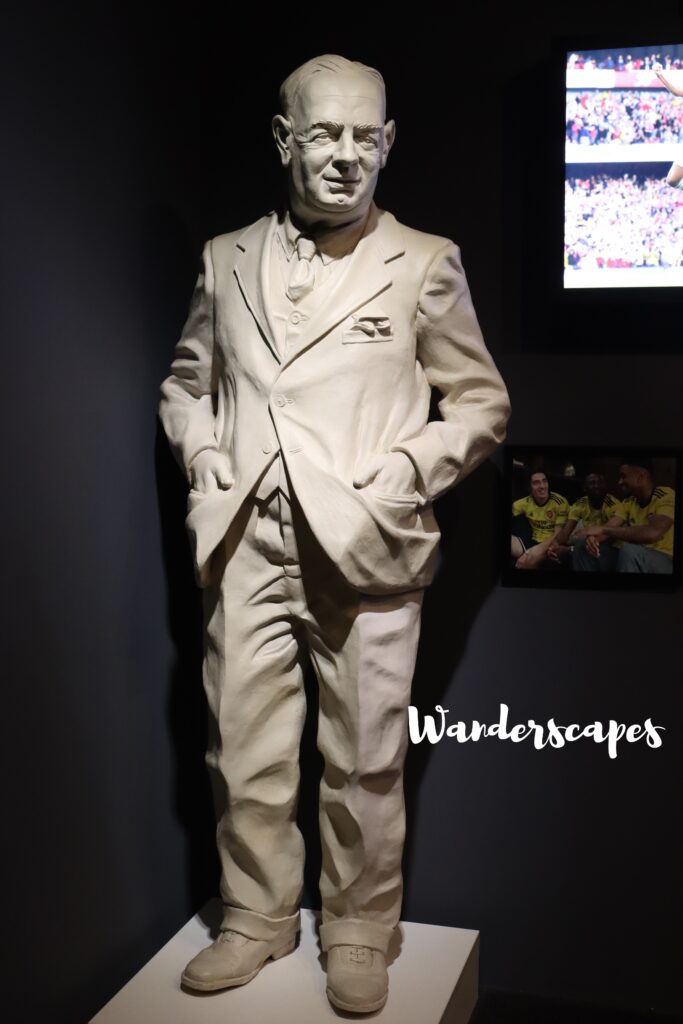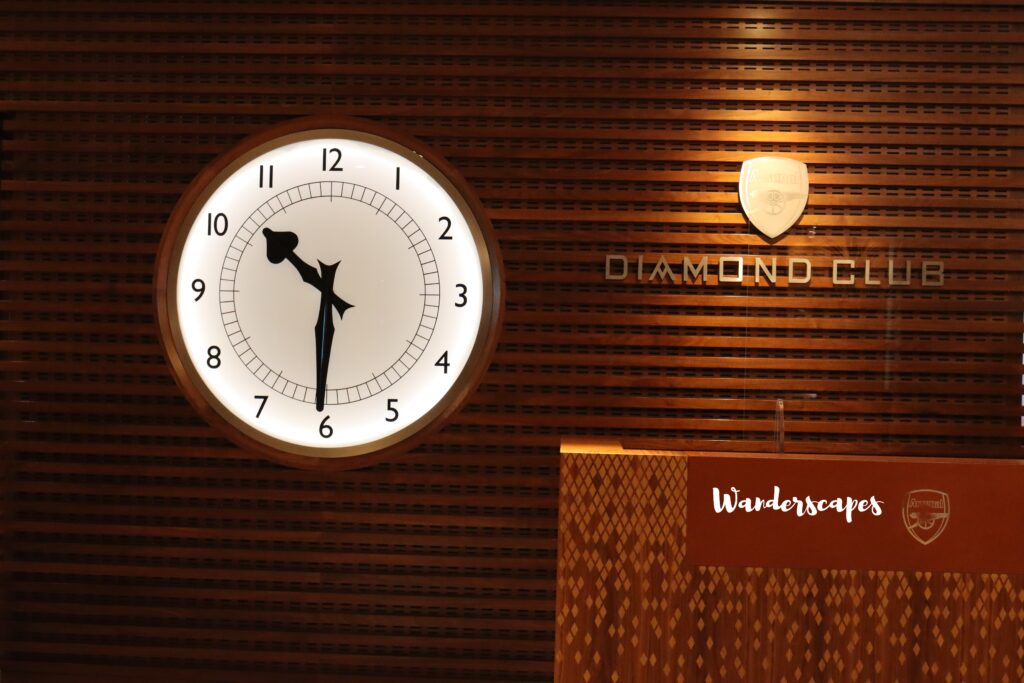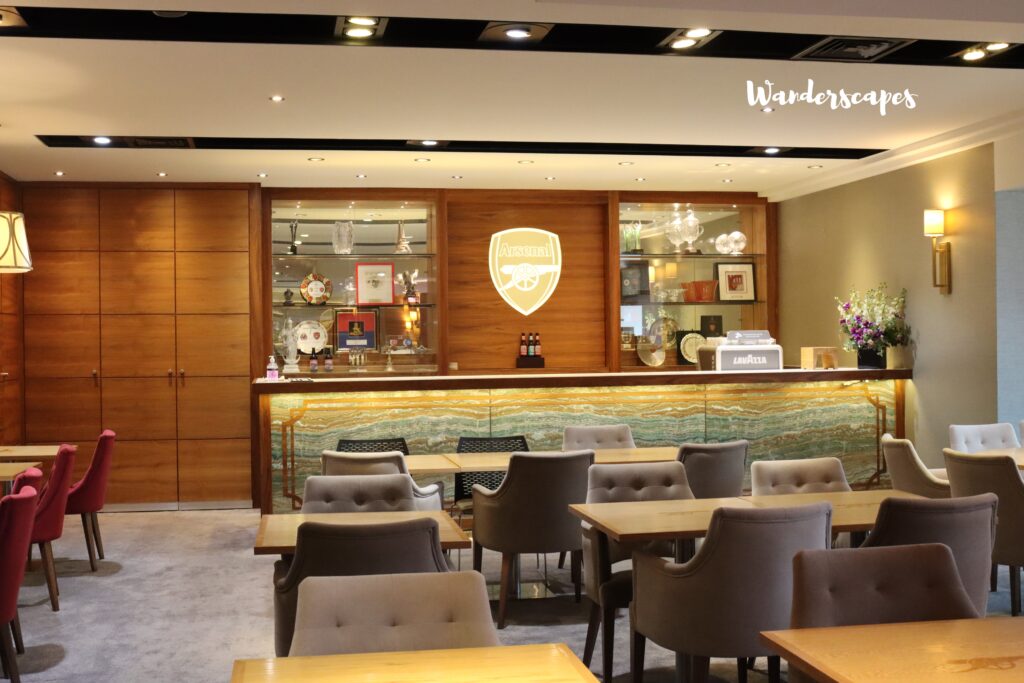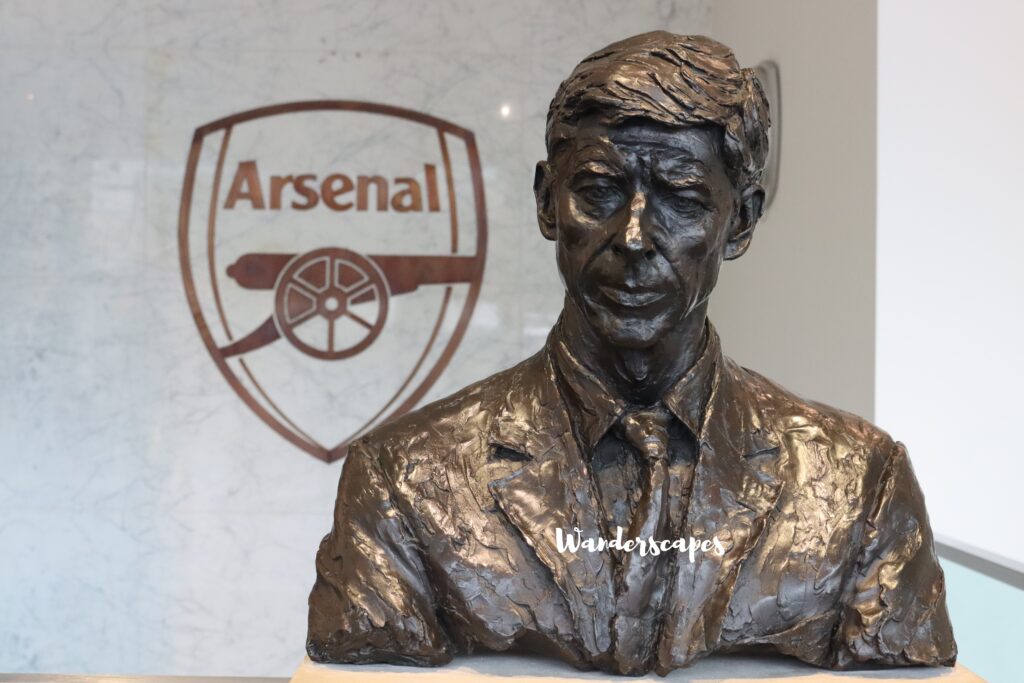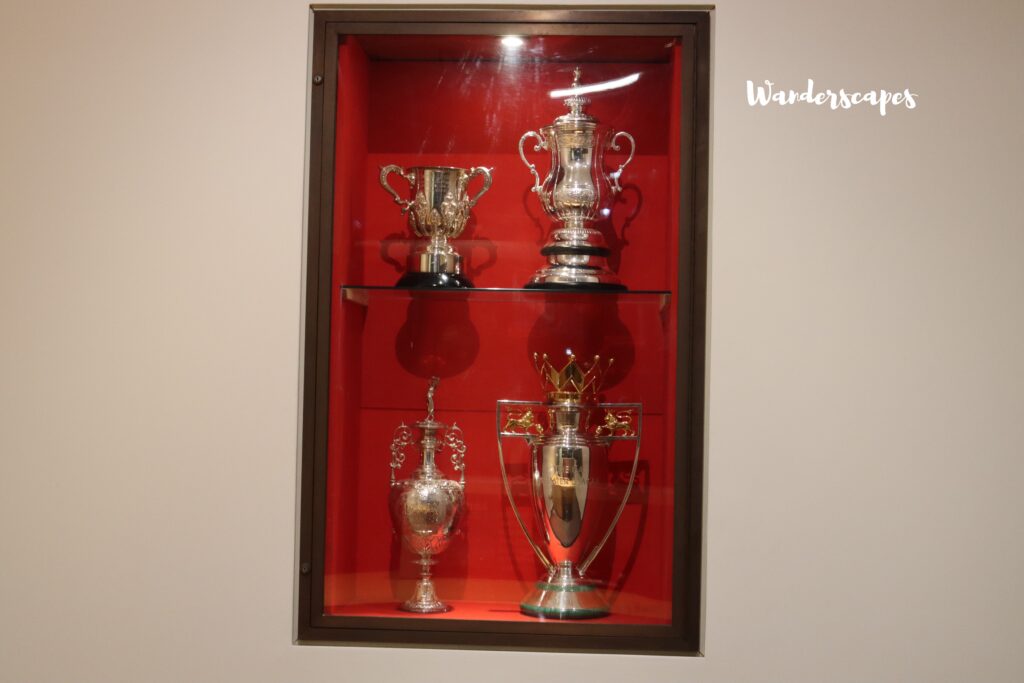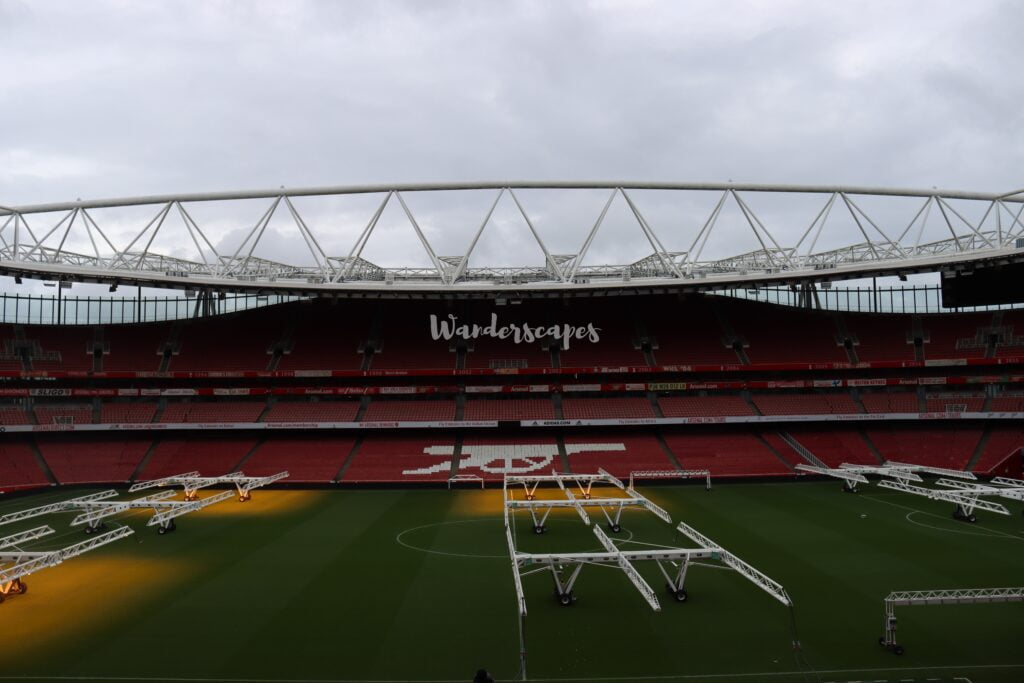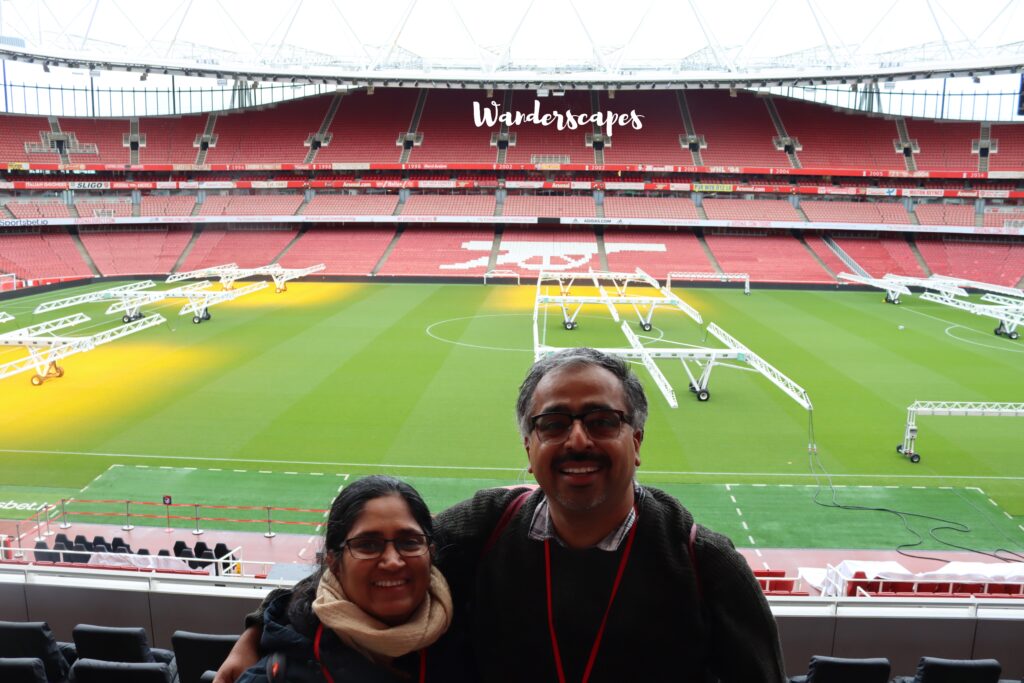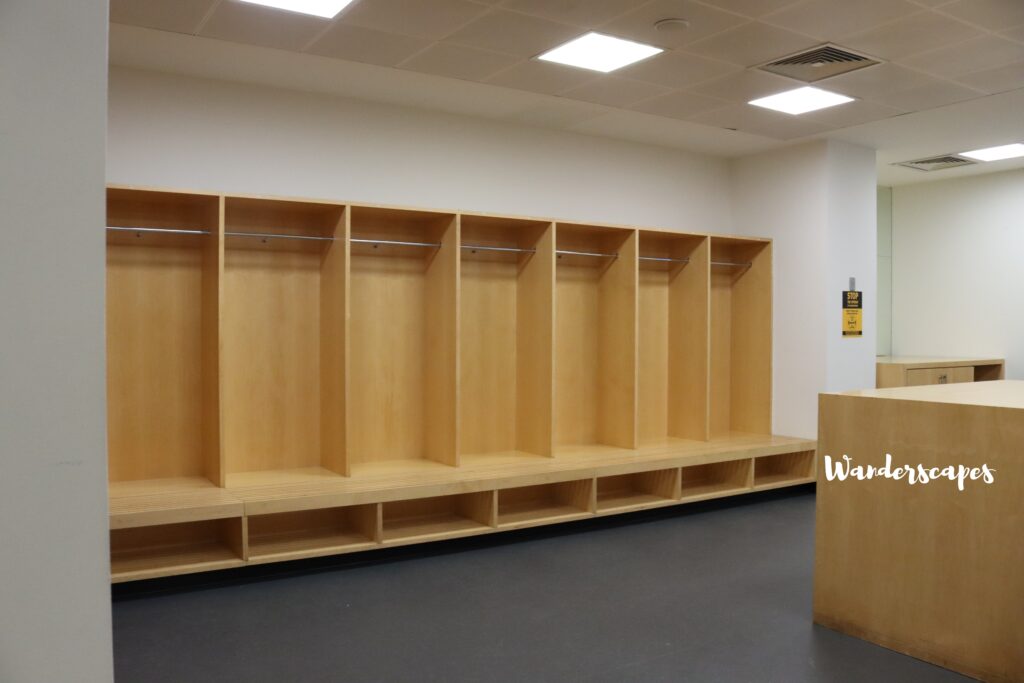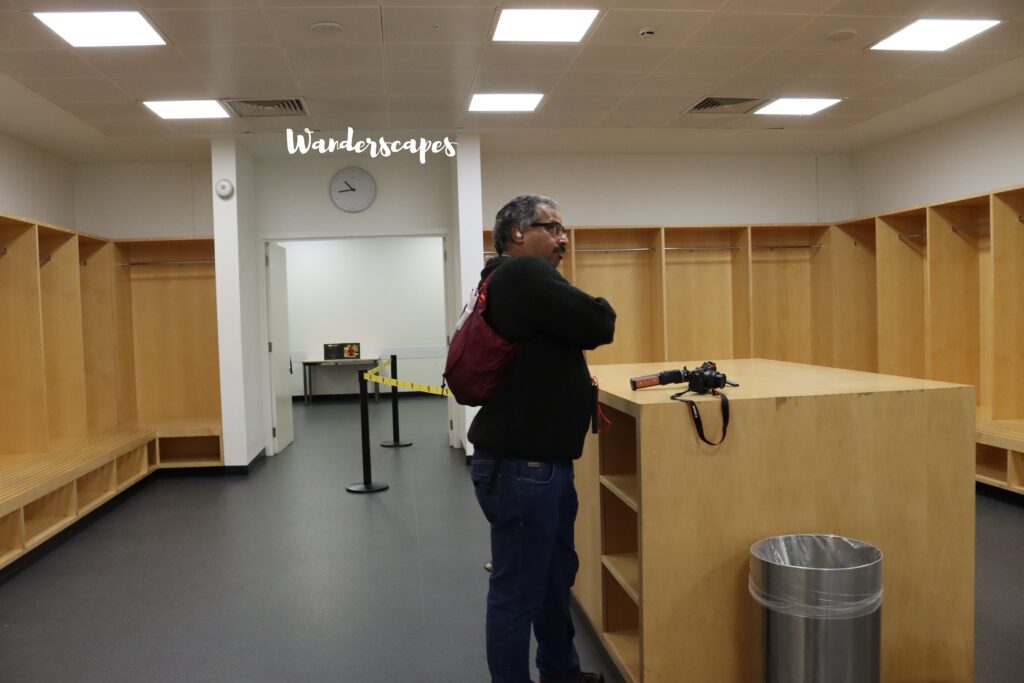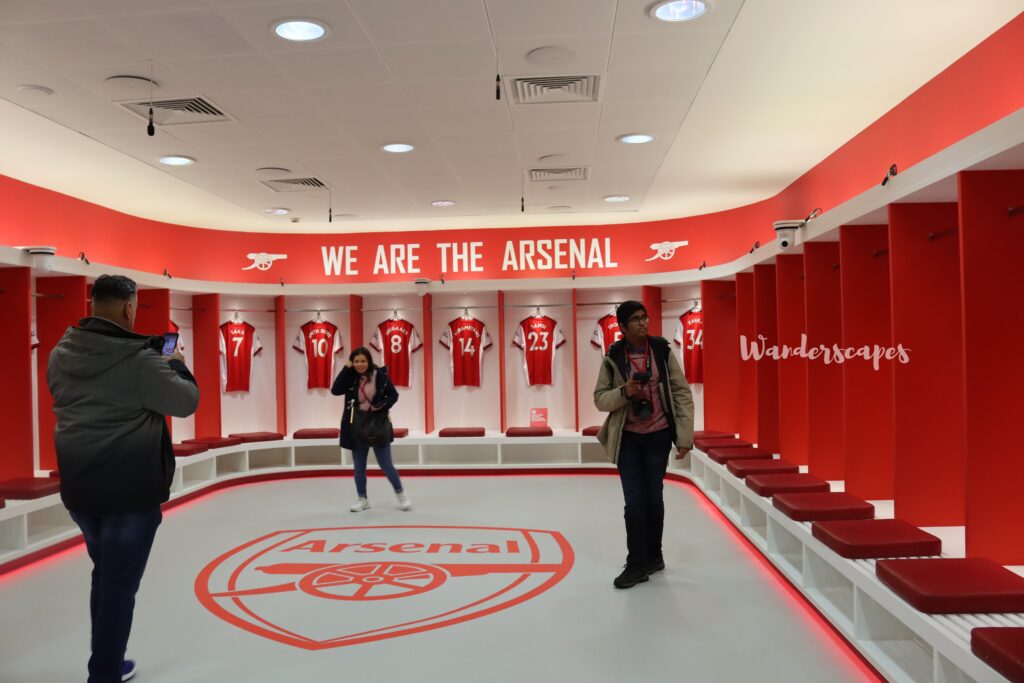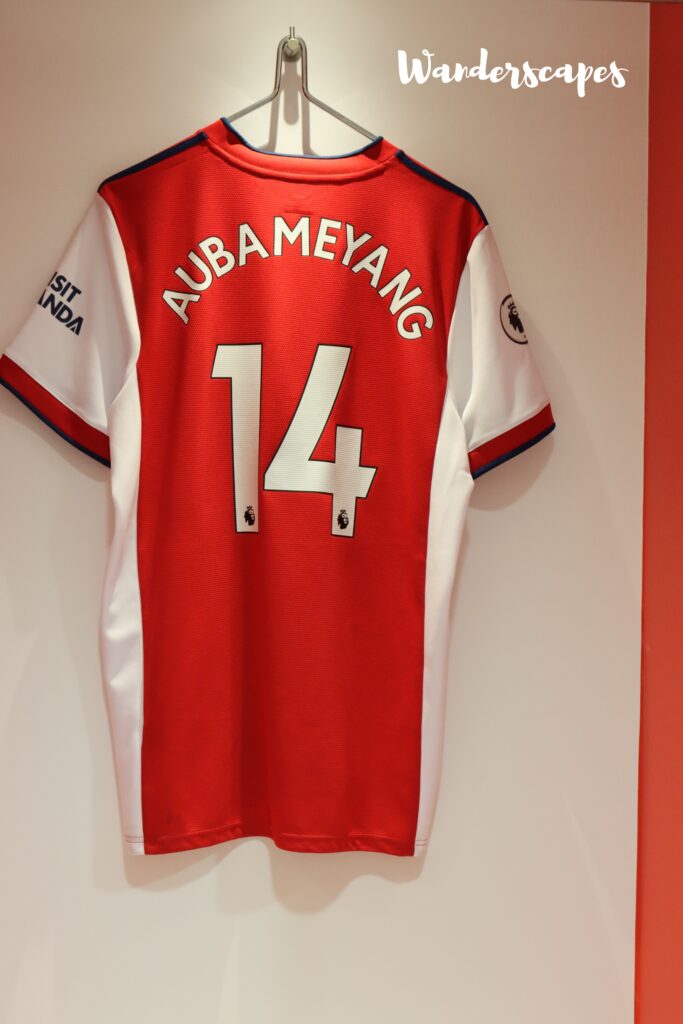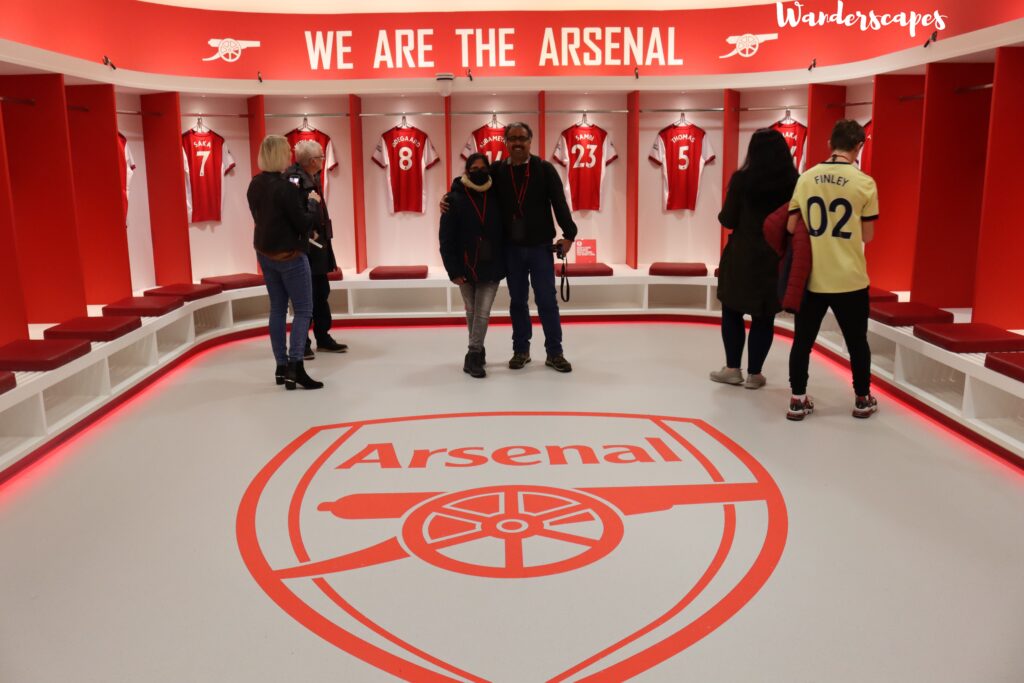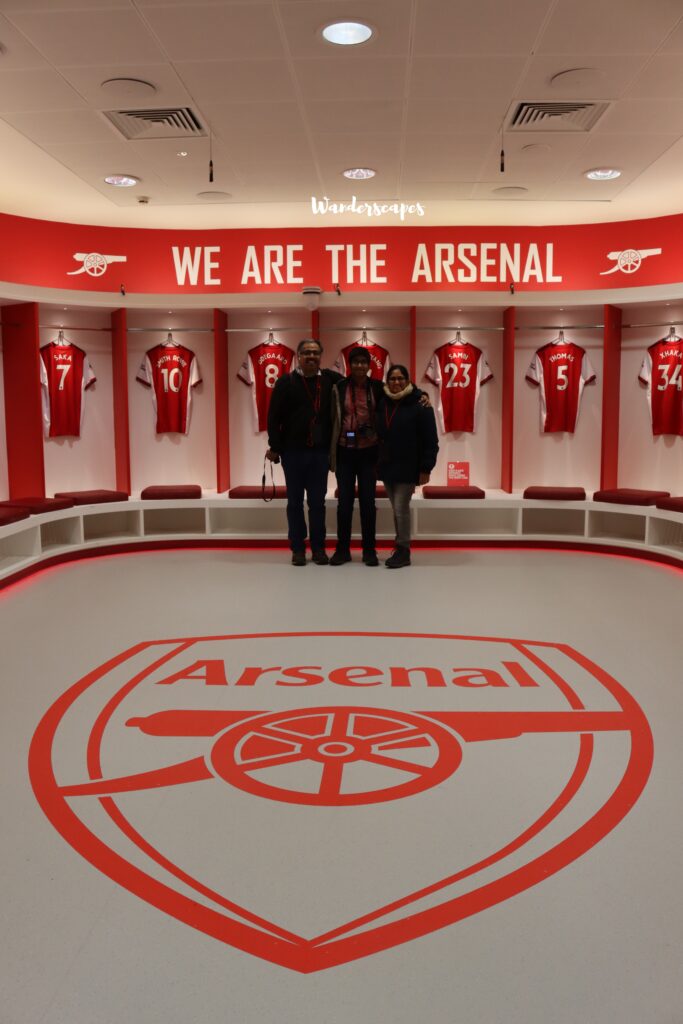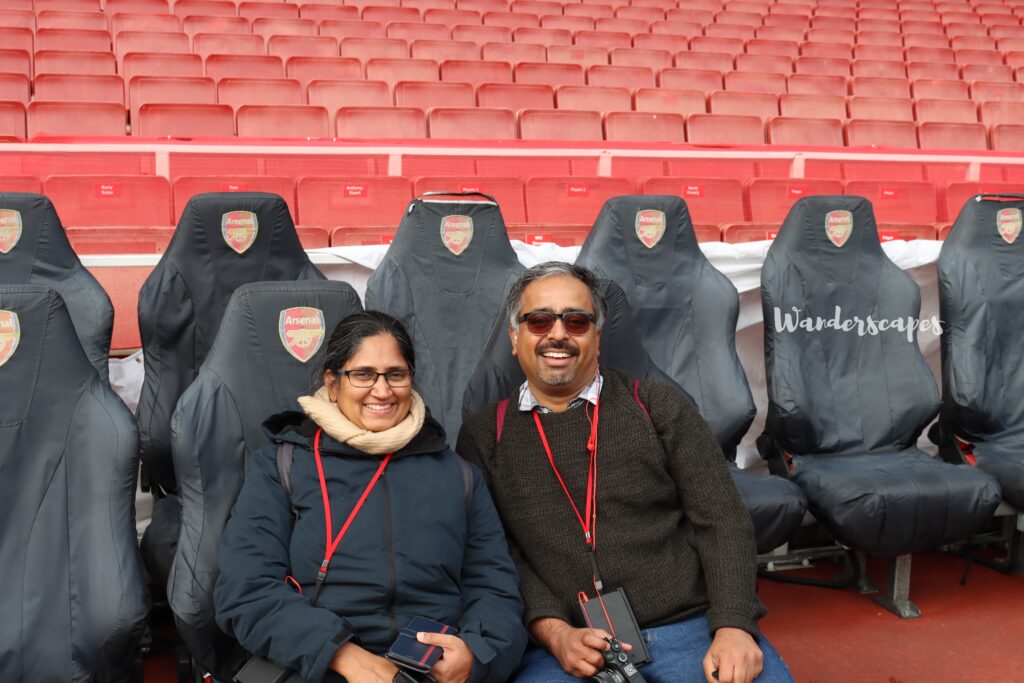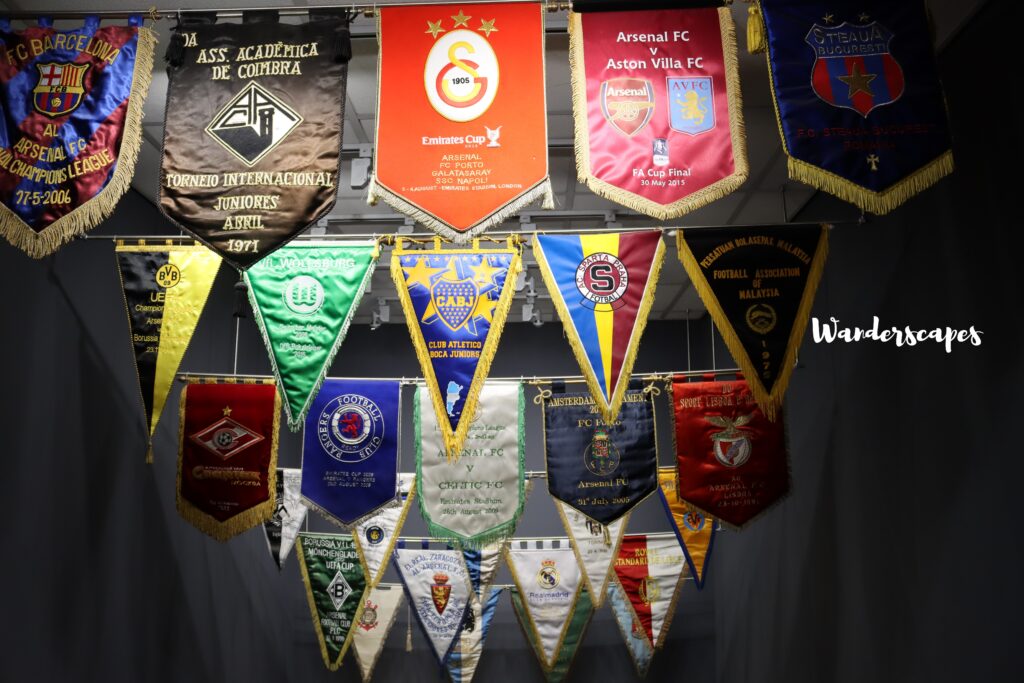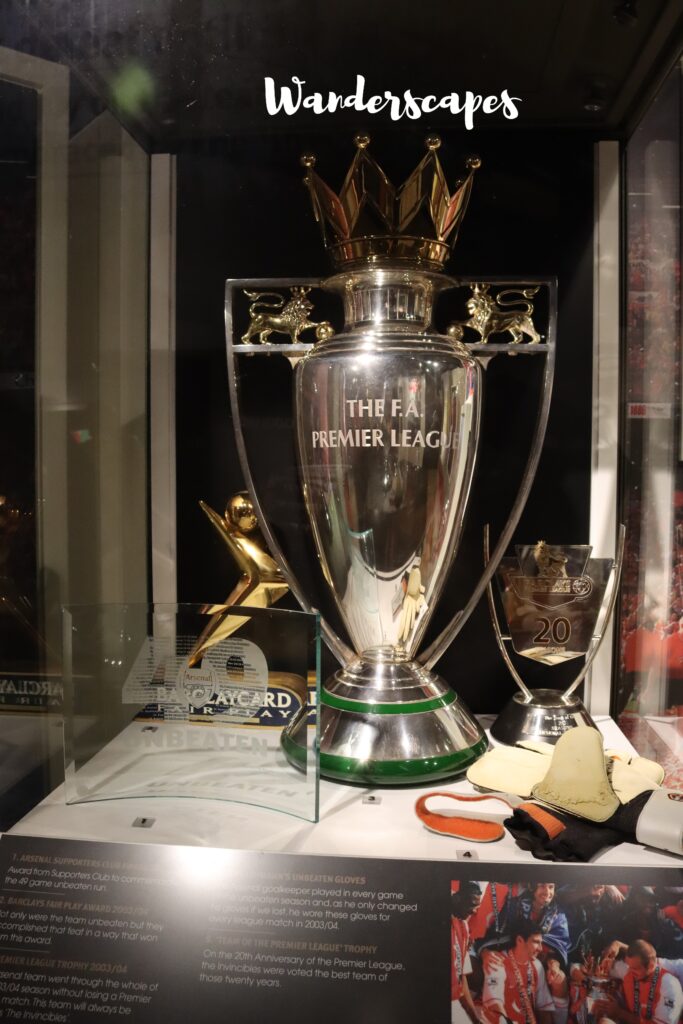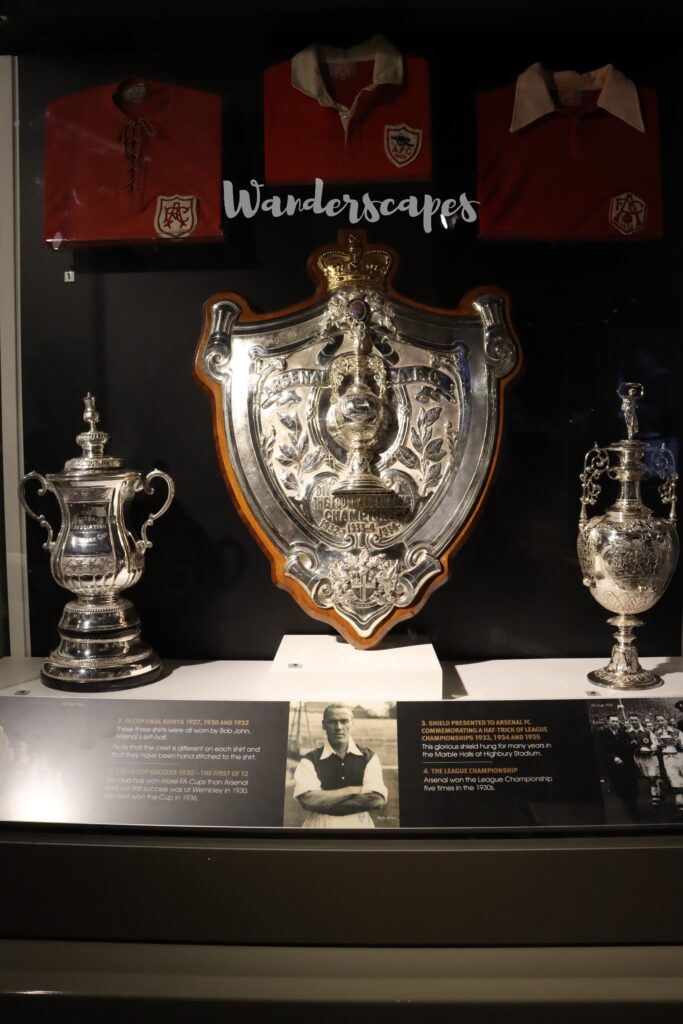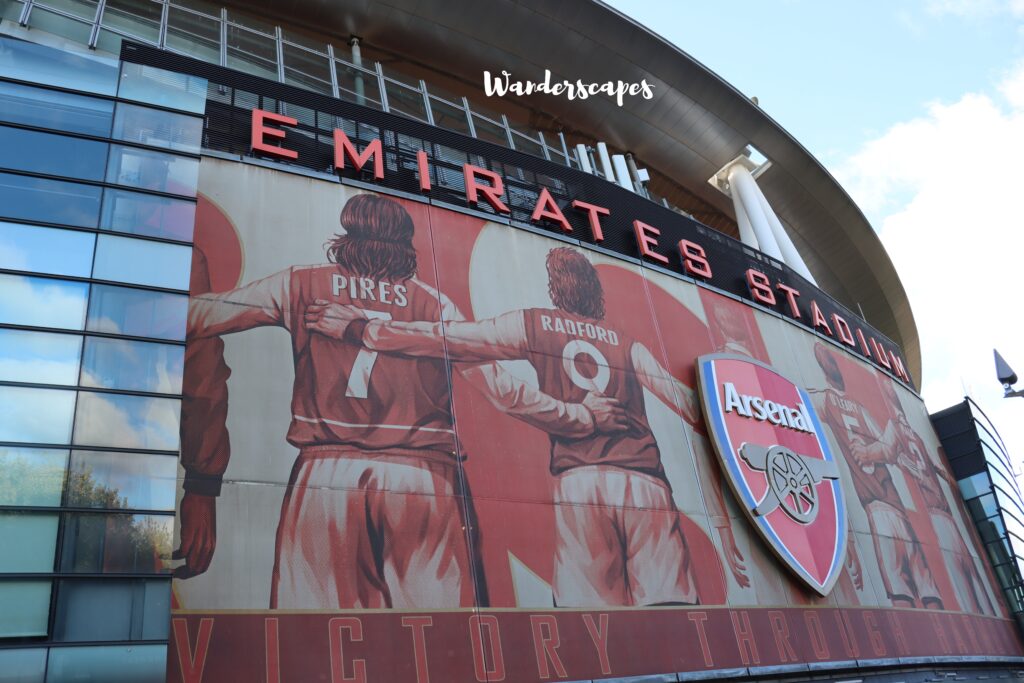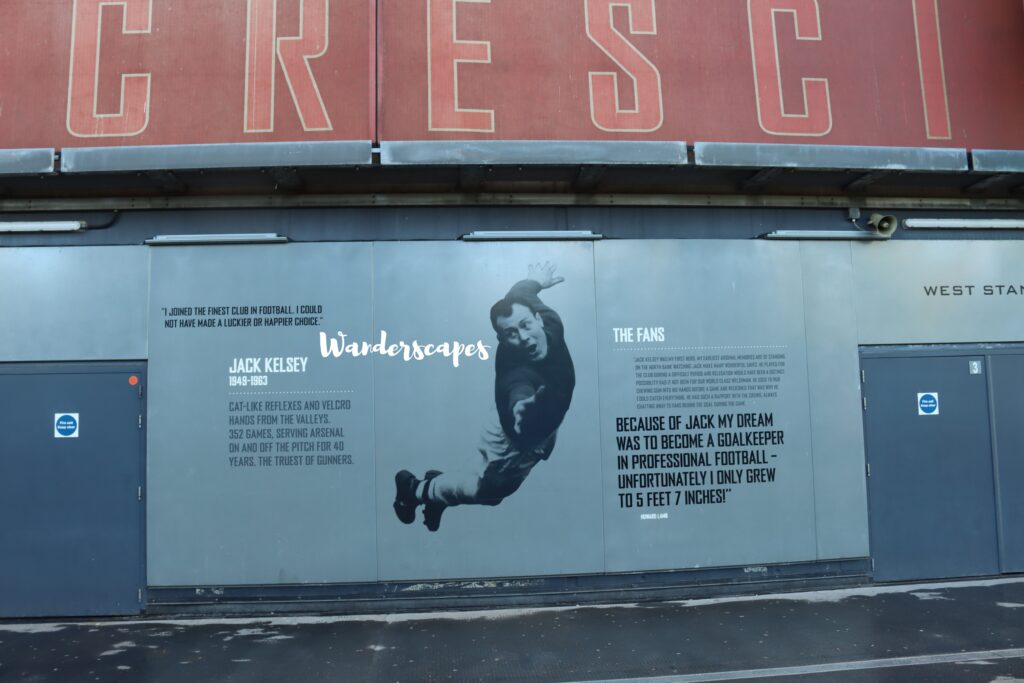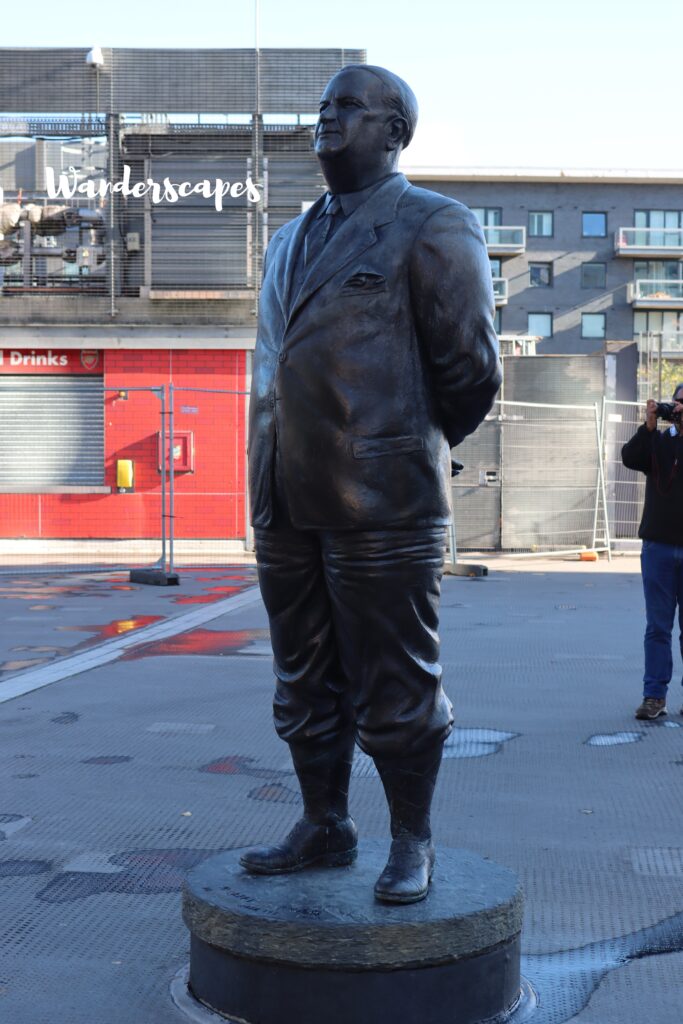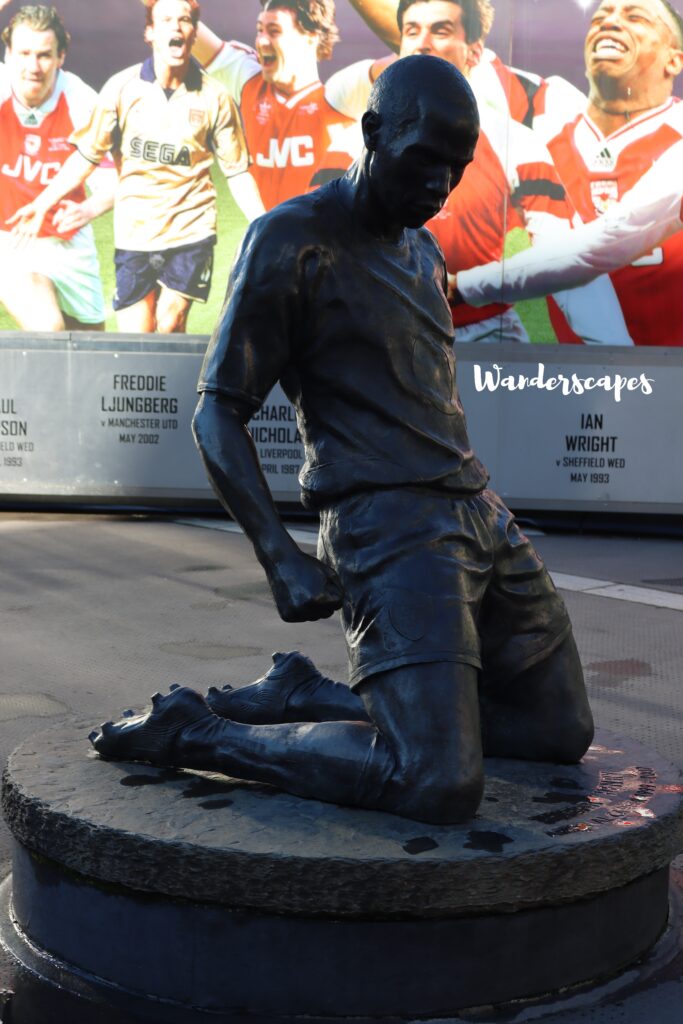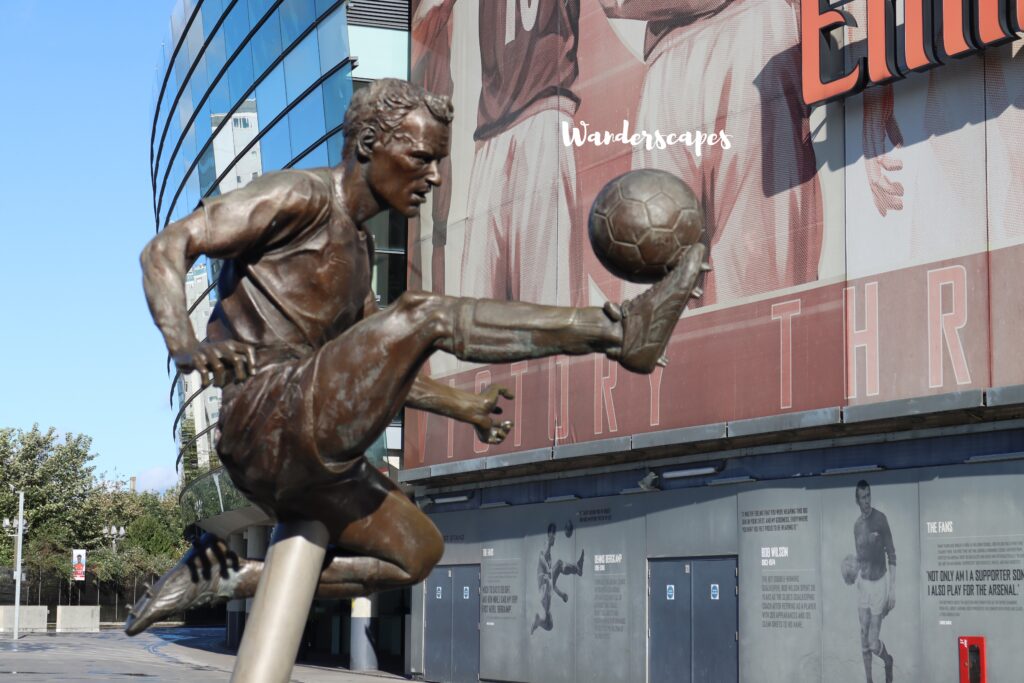As mentioned in an earlier blog, although cricket is our first love when it comes to sports, we follow and enjoy other sports too. Living in Liverpool means soaking up a lot of football action (and loving it!). Although our favourite team is LFC, we like visiting other clubs and seeing their stadiums. So, a cold, wet morning saw us boarding a train from Liverpool to London. Our destination? Arsenal FC’s home, Emirates Stadium.
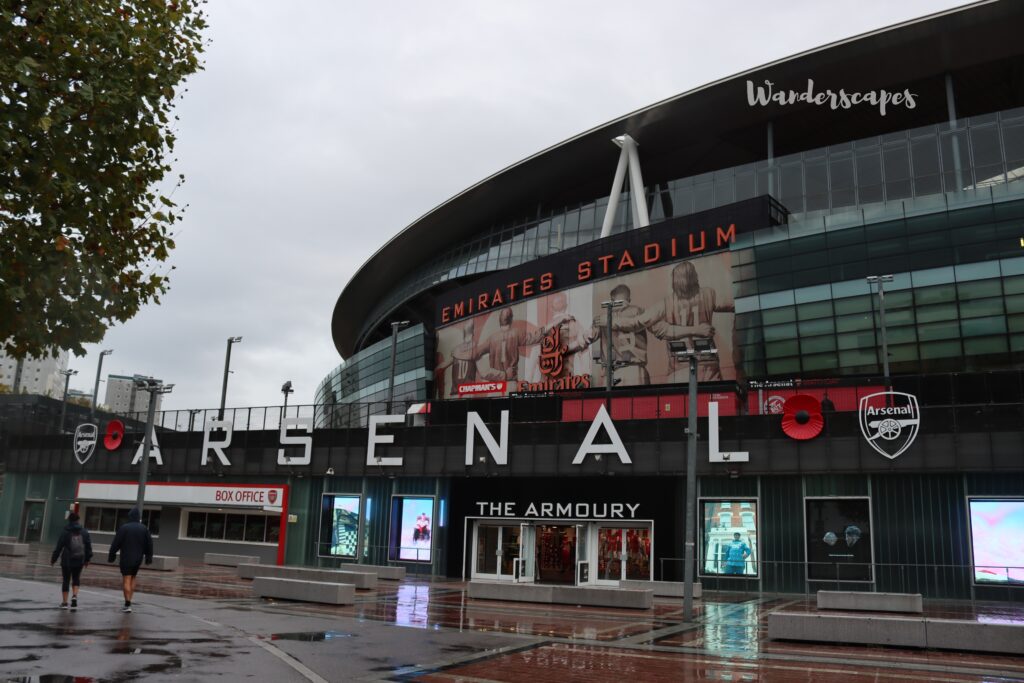
A Club Founded by Munition Factory Workers
Arsenal Football Club is an English football club based in Islington, London, England. A group of workers (Scotsman David Danskin and fifteen fellow munitions workers) from the Woolwich Arsenal Armament Factory formed a football team in 1886. They named it Dial Square as a reference to the sundial atop the entrance to the factory. However, a month later, they renamed it Royal Arsenal. The club’s first home was Plumstead common. But they played mostly at Manor Ground.
Becoming Arsenal
The club changed its name again in 1893 to Woolwich Arsenal, and again to The Arsenal. However, in 1918-19, the club dropped ‘The’ from its name and became ‘Arsenal’. The club plays in the Premier League, the top flight of English football. An illustrious club with a rich history, Arsenal has won 13 league titles (including one unbeaten title), a record 14 FA Cups, two League Cups, 16 FA Community Shields, the League Centenary Trophy, one European Cup Winners’ Cup, and one Inter-Cities Fairs Cup. One of the Big Six English clubs, Arsenal has a strong fan base across the world.
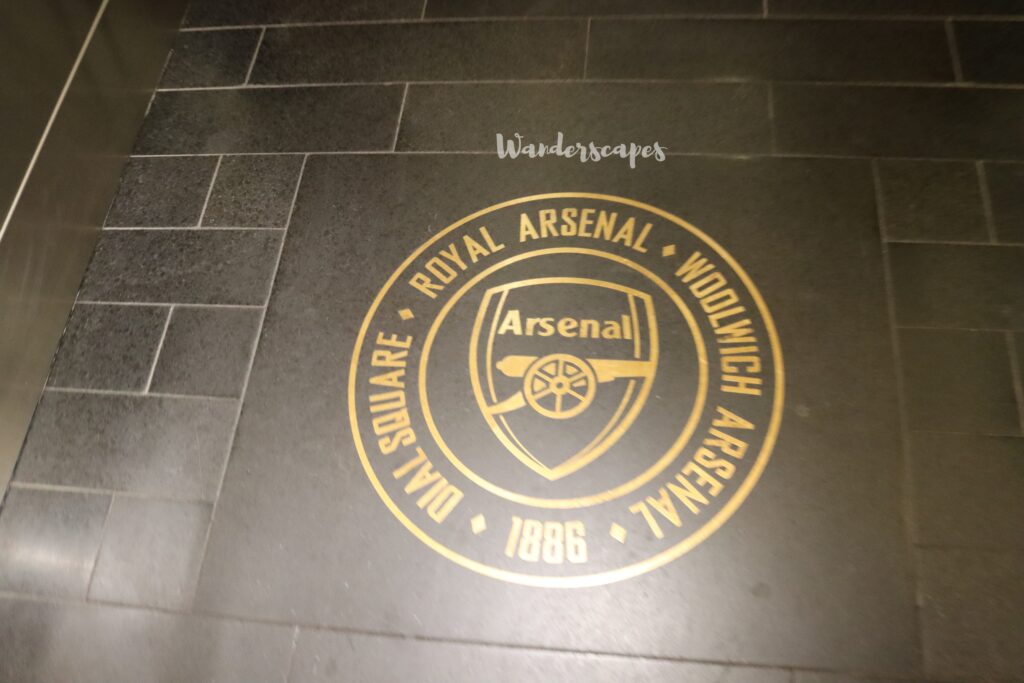
Various Stadiums and Grounds in Arsenal’s History
As mentioned earlier, Arsenal’s first ground was Plumstead Common. However, in 1913, they had to move to Highbury as the Plumstead stadium was burnt down during the suffragette movement. Highbury remained the club’s home for over 90 years. Renowned football architect Archibald Leitch designed the original stadium. Its maximum capacity was 57000, which became 38000 in 1993-94 due to safety rules and regulation changes.
An expansion of Highbury was not possible because East Stand was a Grade II listed building and the other sides were close to residential properties. The limited capacity affected the club’s revenue and hence, a new stadium was the need of the hour. Accordingly, Arsenal built a new 60000 capacity stadium at Ashburton Grove, or the Emirates Stadium as we know it. It is called so because of sponsorship rights. The airline is the club’s shirt sponsor until 2024 and that of the stadium until 2028.
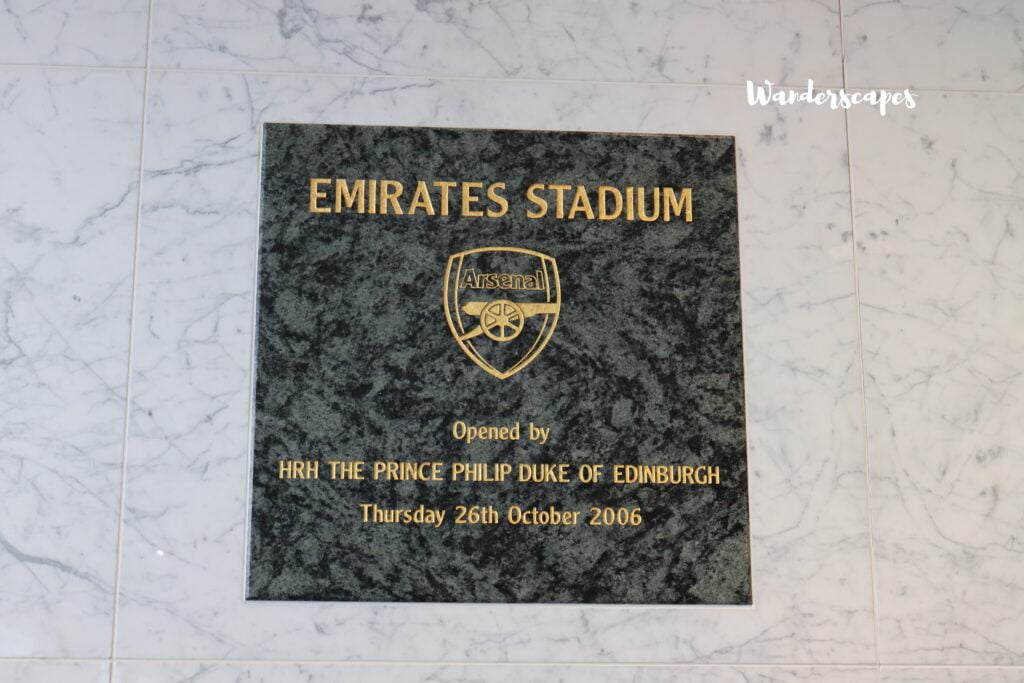
The Chapman Era
One of the most successful and illustrious managers of the club was Herbert Chapman. He became the club’s manager in 1925 and spearheaded Arsenal’s success over the next five years. The club’s gate revenue increased, and its performance peaked. As a result, Arsenal won FA cups and league titles in the early 1930s.
Chapman is considered a visionary manager in English football history. His contribution include innovations such as introducing shirt numbers, kit and several team management concepts.
Although Chapman passed away in 1934, the new manager continued his legacy and led the team to greater victories. However, by the early 1950s, the club’s performance suffered and it became mediocre, to say the least. The ups and downs continued until 1996 when Arsene Wenger took the reins of the club and steered it to newer heights and memorable performances.
Arsene Wenger – the Most Successful Arsenal Manager?
The French manager overhauled the fitness and dietary practices and Arsenal started playing attacking football under him. Arsenal finished in either first or second place in the league in eight of Wenger’s first nine seasons at the club. However, the most incredible feather in his cap was when Arsenal won the Premier League in 2003–04 without losing a single match, an achievement which earned the side the nickname “The Invincibles”.
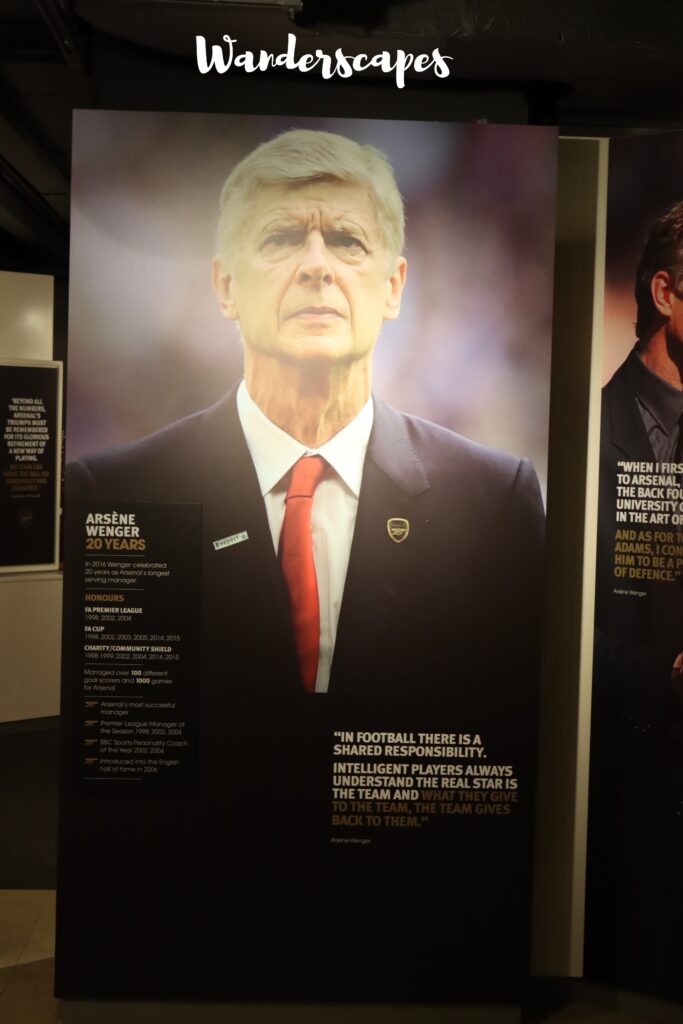
Our Visit
We arrived at Islington in the morning well ahead of opening time, soaking wet. However, the staff welcomed us warmly and did everything to make our visit comfortable. They went out of their way to guide us through the facilities and to explain things. They are by far, the best staff we met in all our stadium tours until now. Kudos to them.
The Emirates Stadium tour is self-guided. The staff handed us an audio guide and showed us how to use it. Once we familiarised ourselves with its features, we set off on the tour. The audio guide had all the details and we listened and saw everything.
Diamond Club and Golden Replica
First, we saw the Diamond Club. It has great lounging facilities for VIP members and important visitors. The main attraction here is the golden replica of the 2003-04 Premier League trophy presented to the club for their invincible performance – winning 49 matches undefeated.
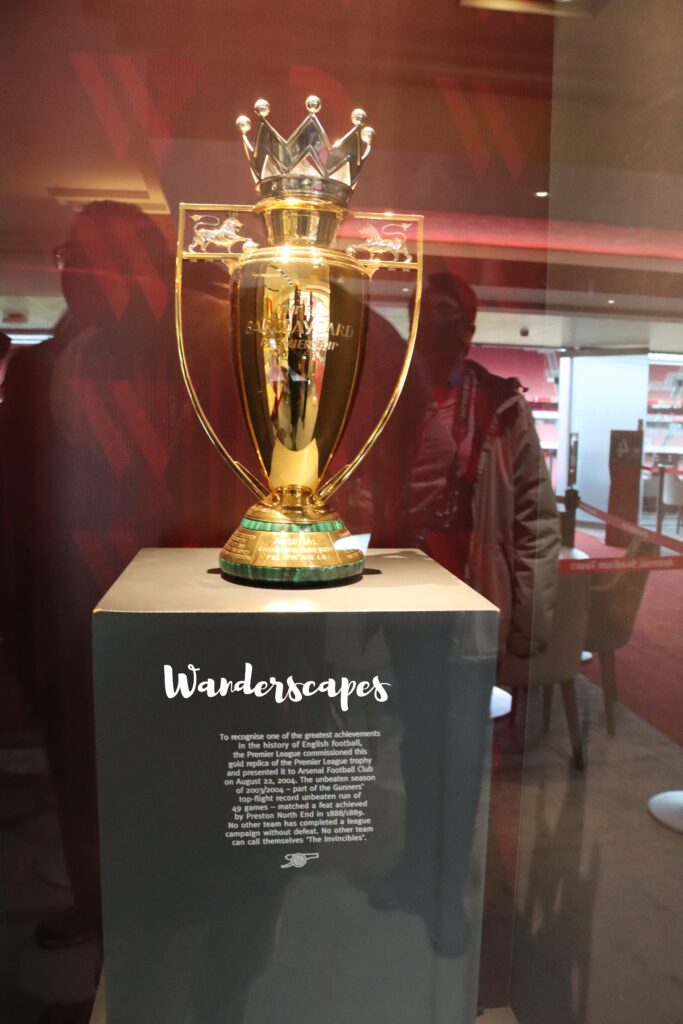
There was the bust of Arsene Wenger, along with the snapshots of other achievements listed along the walls.
View of the Arsenal Home Ground
From there, we entered the stadium to enjoy a spectacular view the ground. As the tour is self-guided and self-paced, there weren’t any crowd or rush and so we enjoyed the view at leisure. After clicking a few snaps and taking in the view, we headed to the next spot on the tour guide.
Players’ Entrance and Dressing Rooms
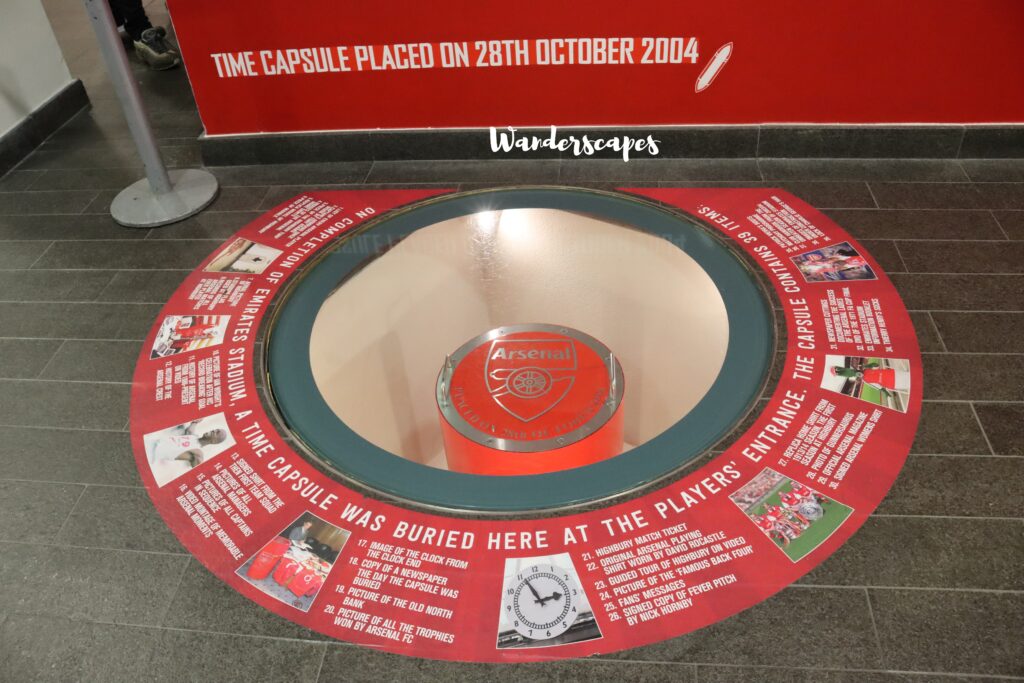
We saw the players’ entrance and the huge crest that welcomes the players and officials on a match day. Another attraction worth mentioning is the time capsule put in there in 2004 when the stadium was under construction. Then, we took a pic with the FA cup, walked through the pre-match tunnel, and reached the away team dressing room.
The away dressing room was so bare and plain that we couldn’t hide our disappointment. Usually, the away dressing rooms have some rival players’ jerseys hanging in there to give a sense of it all. Here, absolutely nothing but bare shelves stared back at us as we stood there.
From there, we headed to the home dressing room, which, thankfully, was done in great taste. We spent some time there – enjoying the display, clicking pics, and chatting with the staff who readily answered some of our questions.
To the Pitchside
We then walked through the players’ tunnel to the pitchside. Usually, they play the home team anthem or song for the visitors when we walk through the tunnel to the pitch to give us a sense of the matchday feel. However, nothing of that sort happened on this tour. The only sound we heard was the horrible noise made by the rainwater falling onto the tunnel roof from the upper stands.
Nevertheless, the ground was beautiful. We sat at the home team dugout and imagined the a festive mood on a match day. The most exciting part of a stadium tour is when we go to the pitch side and sit at the players’ dugout. That is an an exhilarating experience – no matter how many stadiums you visit. Here too, the thrill was no less.
Other Sights
We walked back through the tunnel to see the player interview rooms, press conference room, and the current manager Mikel Arteta’s office. The visit to the manager’s office was the most unique experience on this tour. This was the first time we actually went inside a manager’s room. It felt special.
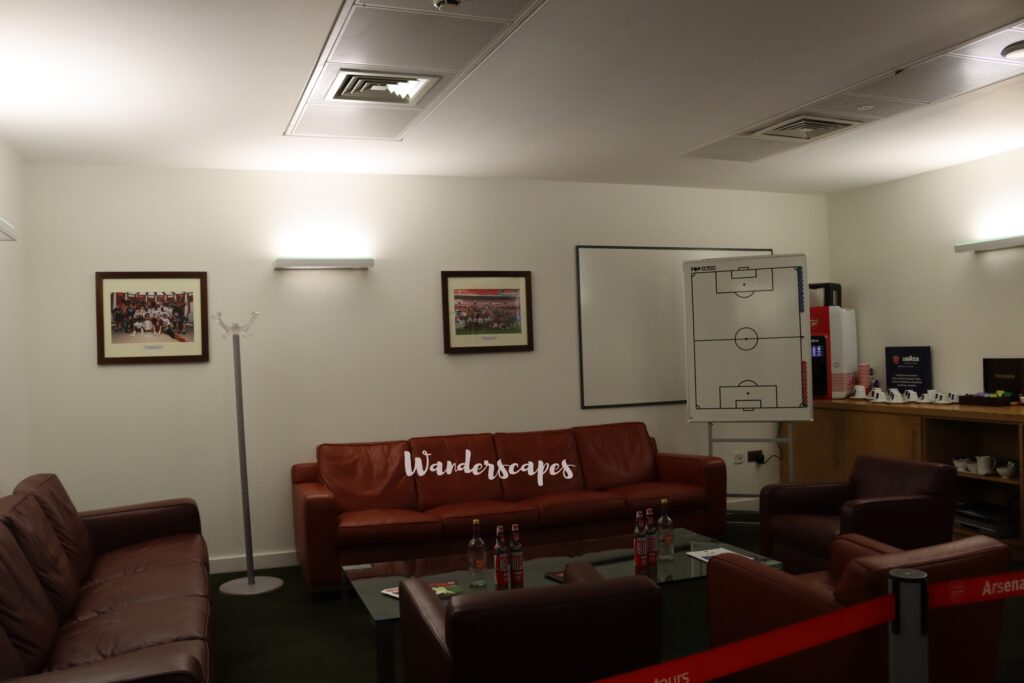
Manager’s office 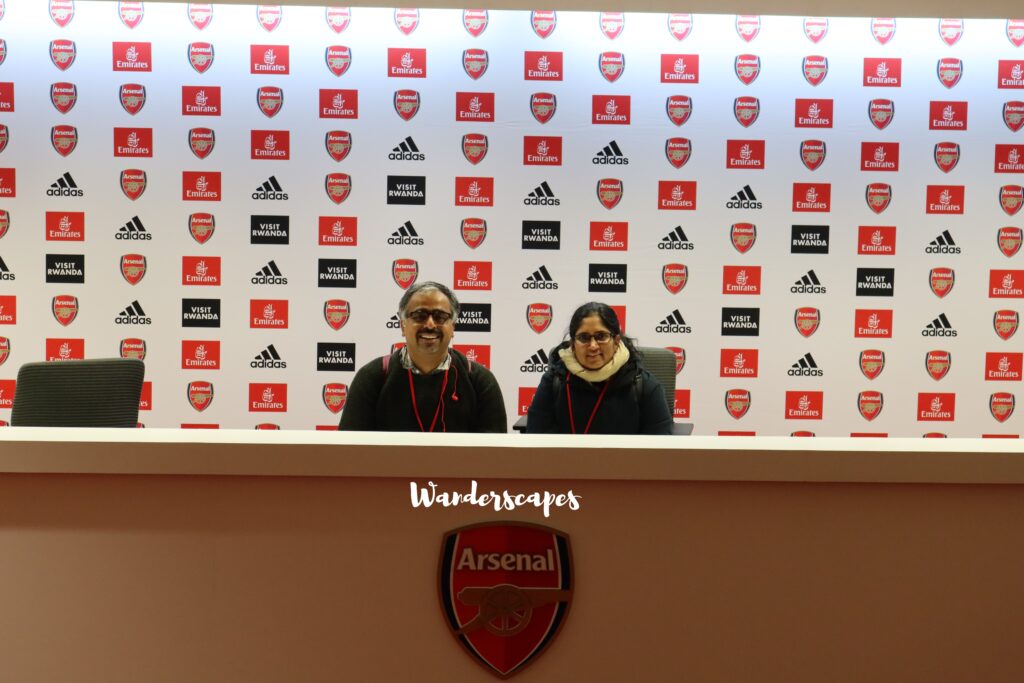
Press conference room
The Arsenal Story – Museum
After the stadium tour, we visited the Arsenal Museum. Named Arsenal story, it showcases the club’s history from the start to the present. We learned more about Herbert Chapman, various stadiums, and other important milestones in Arsenal’s history. The museum exhibits were in two broad sections – pre-1950s and post 1950s. The museum is a treasure trove of information for those who love history and is a must-visit for an Arsenal fan. If you have time on hand, you could spend hours there looking at all the displays.
End of the Visit
After exiting the museum, we walked around the stadium. The walls were full of player details – their pics, playing position, manager’s comment, and fans’ opinion. There is enough space around the stadium to enjoy a leisurely walk. Thankfully, the rain had stopped by then and so we could walk around and enjoy the scenes.
There is a statue of Herbert Chapman at the Clock end. At another corner, there is a statue of Thierry Henry, the all-time top goal scorer (228) for the club. The celebration corner beside the statue showed pictures of players celebrating their goals in their unique style. Further ahead, there was a statue of Dennis Bergkamp, another legendary Arsenal player.
Soon, it was time for us to bid bye to Arsenal and head to our next destination. We shall be back with that story later. Stay tuned for that. In the meantime, check out our vlog of this visit here.
Some Arsenal Trivia
- Arsenal’s fans are referred to as “Gooners” – the name derived from the club’s nickname “The Gunners”
- Arsenal’s longest-running and greatest rivals are their nearest major neighbours, Tottenham Hotspur. Matches between the two clubs are referred to as North London derbies
- Other London rivals include Chelsea, Fulham, and West Ham United
- Arsenal and Manchester United had a strong on-pitch rivalry in the late 1980s, which grew when both clubs were competing for the Premier League title
- The club mascot is Gunnersaurus Rex, a smiling, 7-foot-tall green dinosaur. Mr. Jerry Quy has been inside the suit from the start
- Thierry Henry is the club’s top goal scorer with 228 goals in all competitions between 1999 and 2012
- American sports tycoon Stan Kroenke is the major shareholder on the Arsenal board
- Arsenal has won 13 league titles (including one unbeaten title), a record 14 FA Cups, two League Cups, 16 FA Community Shields, the League Centenary Trophy, one European Cup Winners’ Cup, and one Inter-Cities Fairs Cup
- Arsenal’s tally of 13 League Championships is the third highest in English football, after Manchester United (20) and Liverpool (19)
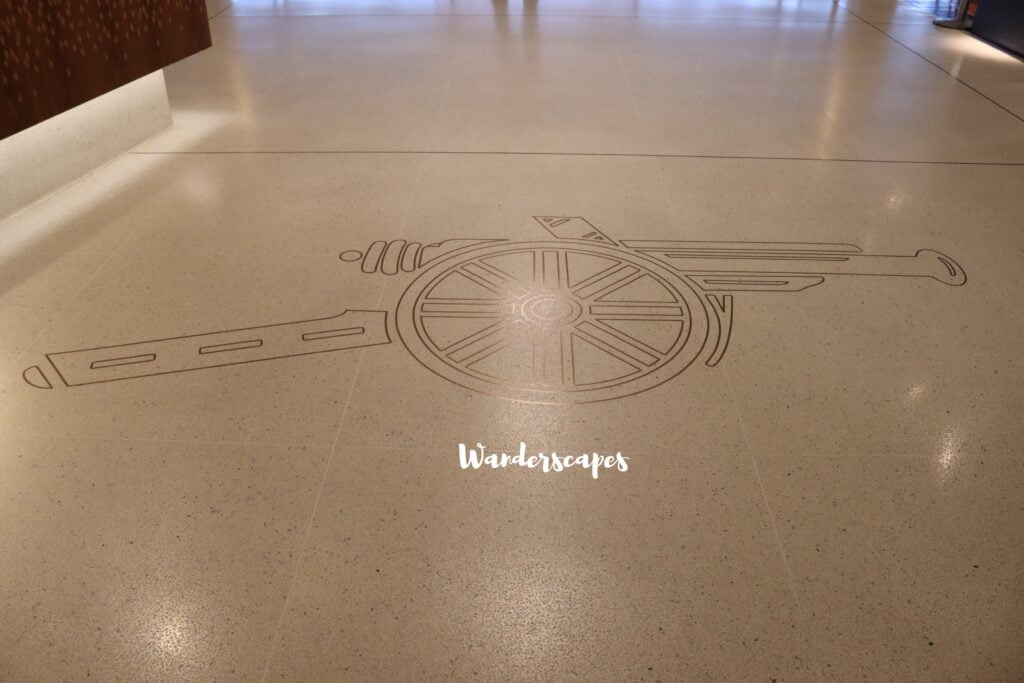
Arsenal’s Records
- They hold the highest number of FA Cup trophies (14)
- Arsenal have been in the top flight for the most consecutive seasons and was relegated only once, in 1913
- Gunners hold the record for the longest run of unbeaten League matches (49 between May 2003 and October 2004)
- Arsenal played the first football match involving shirt numbers. Back then, one team wore numbers 1-11 and the other 12-22
- Arsenal’s match with Sheffield United on January 22, 1927, was the first live radio broadcast of a football match by the BBC
- The club was also involved in the first live television broadcast of a football match in the world by the BBC, when they faced Arsenal Reserves at Highbury on September 16, 1937
If you know is any other interesting Arsenal trivia, please share it in the comment box at the bottom of the page.
Our Verdict of Arsenal Stadium Tour
This is our fourth football stadium tour. By now, we know what to expect and so it wasn’t an overwhelming experience. The most disappointing part of the tour was the ‘bare’ away dressing room. The most unique experience was seeing Mikle Arteta’s office. We would also like to give a shout out to the wonderful staff in the stadium and museum. They were friendly, helpful and made us feel welcome. All in all, the experience was good. We will recommend it to all Arsenal fans. Also, if you are a football fan, you will find the Arsenal story quite enlightening because it tells a lot about the evolution of the game.
How to Get There?
The stadium is at Hornsey Rd, London, N7 7AJ. It is advisable to travel by public transport as parking could be a huge worry if you drive to Emirates.
The easiest way to get to Emirates stadium is by tube. Emirates Stadium is within a few minutes walk of both Arsenal and Holloway Road tube stations. Arsenal (Piccadilly Line) is the nearest tube station, around three minutes walk from the ground. Finsbury Park (Victoria, Piccadilly Lines and Great Northern rail) and Highbury & Islington (Victoria Line, North London Line and Great Northern rail) stations are around a 10-minute walk.
Euston and King’s Cross are the main connecting stations for national rail and many underground lines. From there you can travel to the stadium via the Piccadilly Line (to Arsenal) or the Victoria Line (to Highbury & Islington). Alternatively, a short over ground rail journey of one stop will take you to Finsbury Park station.
To know more details about the Emirates Stadium Tour, including the ticket prices and timings, click here

